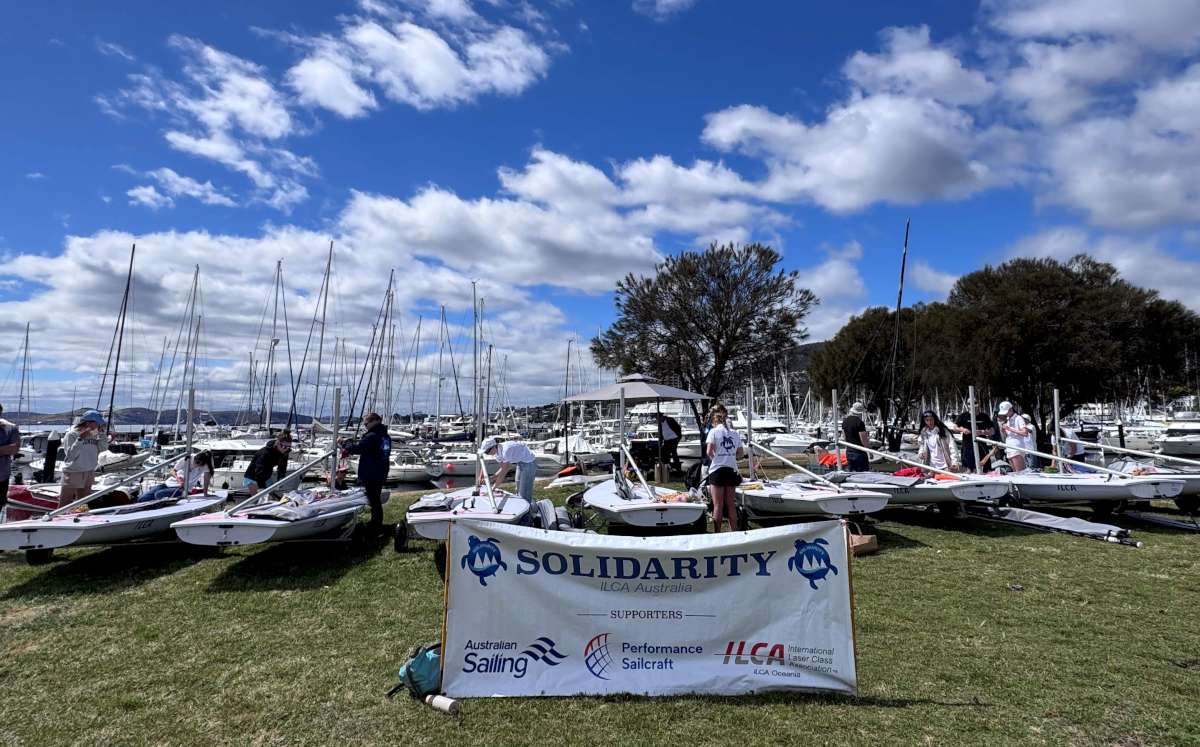From the relative safety of the house we used to call home, we found ourselves to be little affected by the weather.
Sure, if it was raining it might be inconvenient to get to and from the car on the way to work, or we might need to drop children at school who would otherwise get wet walking. Back then, weather affected our lives in only the smallest of ways. But from the moment we began this cruising life and swapped a house for our yacht, it all changed!
The weather affects everything. Our comfort in port, our safety at sea. Suddenly listening to the evening weather report was the most important part of our day, so we could anticipate and prepare for the day ahead. But it was not enough.
If we were going to venture out we needed more information than what was on offer. We began to devour the Bureau of Meteorology (BOM) site, searching for clues to unravel the mysteries of the weather!
For our first major passage across the Great Australian Bight we secured the assistance of the eminently-qualified and very kind Bob McDavitt, of the New Zealand Bureau of Meteorology. Weather routing guru, long-time friend to sailors and our newest supporter, Bob explained to us that weather is a mixture between chaos and pattern.
Since those early days we have come to see that having a healthy respect for that which no man can control and attempting to understand, in its various and varying patterns, is foundational to good seamanship.
Our job as cruisers is to understand the pattern and manage the chaos.
Understanding the pattern
There was so much to learn when we began and it did, at times, seem incredibly daunting trying to figure out the connection between all the data available and the actual outcome.
The starting point for most of us is to understand what is contained in a synoptic chart. Meteorologists study for years, first the basic scientific discipline, then the specifics of weather. We may not have that privilege, but we can become informed and grow in understanding by listening to the weather reports and observing the outcomes. That is how we learned.
The BOM site contains a synoptic map that charts a four day forecast in twelve hour increments. I read this religiously and then note how the patterns change from what had been predicted, noting also what it felt like to be in different systems. This helped to become familiar with weather concepts but also helped us to be able to translate the information in the synoptic chart with what might happen.
Synoptic charts
Synoptic charts can tell us a lot about the weather situation at a glance.
They indicate the strength of both high and low pressure areas (marked with an H or L), where they are and plot the lines of equal pressure. These lines are called isobars. They also indicate where weather fronts are and what type of front they are.
A high pressure system is a section of air which is sinking. As air falls it warms, preventing clouds from forming, therefore areas of high pressure are often accompanied by fair, stable weather, though not necessarily warm weather.
In summer, they sometimes bring sea and coastal fog. In winter they may bring a lot of cloud or fog. High pressure systems are normally larger and move more slowly than low pressure systems.
A low pressure system is an area of air that is rising. Warm air near the surface will tend to rise, as it does it expands and cools, forming clouds usually meaning the weather will be less settled, often with rain and strong winds.
A ridge is an area of pressure that does not have a closed circulation, it either extends from a high pressure system or is sandwiched between lows.
In the Southern Hemisphere winds move around high pressure in an anticlockwise direction and clockwise in a low pressure system. This is reversed for the Northern Hemisphere. The larger the difference in pressure the stronger the winds will blow, meaning that the closer the isobars are, the stronger the wind will be and the bigger the waves being generated.
Sources of weather information
There are so many places you can refer to in your quest to understand the weather, sources of reliable and clear forecast information.
For a day sail this will likely be all you will really need. The Bureau of Meteorology is the national, official source of all weather information. It is what informs VMR stations, TV, radio, internet and most localised sites. Localised sources of course will have more detailed information regarding the area you are in and are a fantastic resource. BOM is updated twice daily as are many of the sources it feeds: www.bom.gov.au.
In addition there are international sources that rely on satellite information or information provided by buoys located in the ocean. These sources can provide even more reliable information for those venturing out further or for longer. For all our sailing we use Buoy Weather which provides, on a subscription service, a very accurate six day forecast in a very clear, easy to read and understand format: www.buoyweather.com.
In addition, it offers a free two day forecast available for anyone to see.
As far as local sources of information, the two that we have made the most use of are: www.seabreeze.com.au and www.willyweather.com.au.
Once you have set off, weather updates are available via VHF and HF, with weather fax also available via HF. It is a good idea to check for update times when logging on so that you can receive any updates to the official forecast during the course of the day.
Keeping a log of weather data is a great idea so that you can see at a glance any changes to what was expected. On passages we note on an hourly basis our position, our speed over ground (SOG), the wind direction and strength, sea state, barometric pressure and any other significant details.
Weather routing
For longer passages, where getting the weather right is critical, weather routing is an excellent resource.
Weather routing is a professional service that makes use of long-range computer modelling and other technical resources to plan an optimal route for you, using your own boat polars.
The process is that you inform the routing service of your boat details, your planned trip, your needs, likely time-frame etc. and allow them to then advise you of the most suitable route and/or time to travel. Many routing services are also available via the internet, you simply join and then enter your details.
There are a number of services available at varying prices and, of course, with varying levels of support. Some services will provide internet or telephone updates, others a list of positions indicating where to sail to achieve optimal results.
We were very fortunate to have the assistance of Bob when we crossed the Bight and, as this was our first major venture, we were very glad to have such amazing help. Bob planned a route for us and told us when to leave to ensure we were travelling with the best possible conditions. He gave us coordinates and told us what we could expect along the way. He was spot on.
Once we left our last port however, we were pretty much on our own until we hit land again seven days later.
Some of the subscription based services that we have considered using are: www.predictwind.com/, and
www.passageweather.com.
If you are considering using a routing service, the most important element is to use people who are familiar with the area you are sailing!
Listen to local wisdom
We have found that all the reading, all the web-sites and all the technical knowledge in the world will never come close to the wisdom of those who know their local seas.
Wherever we are we always take the time to listen to local fishermen and local sailors to whom the sea is their life. Listening and taking direction from those who really know their own part of the ocean is not only smart and wise: it just might mean the difference between life and death! Nothing will keep you safer on the ocean than getting the weather right!
Managing the chaos
The problem with weather predicting is that it is not an exact science. It can and frequently does, behave other than what was expected.
It is our capacity to understand this and be able to manage it that will, in the end, keep us sailing and keep us safe.
There are just a few simple things that can point us to where the expected pattern has changed and, having become aware of an unexpected change, help us to deal with it.
Use your barometer: in addition to observations about cloud build up, changes in wind direction and speed, the barometer is your most reliable source of information about whether what was expected is going to happen or if something unexpected is unfolding. When sailing, the barometer is our best friend. Checking weather reports before heading out and looking at weather maps is only as good as the moment. The barometer will tell you instantly that something has changed or something is changing. It is attention to this tool that will provide you with the most useful information when you are off shore.
As I mentioned before, we make note of the barometric pressure on an hourly basis. If it differs significantly from what was predicted, if it drops rapidly, we know that we are heading towards a low and we will need to take action.
If the barometer reading remains as expected then it is all good. It’s all about monitoring: observing changes and making adjustments as needed. Have several back-up plans: in any passage-planning it is essential that you consider alternative plans for if the weather behaves differently to what is expected. You need to be aware of harbours and anchorages along the way and the suitability in whatever conditions might come your way. Knowing, for example, that if a westerly blows up preventing you from getting to your destination but an anchorage that is okay in a westerly lies just ahead of your current position and that you can get in with the seas running, will give you somewhere safe to go.
In any passage-planning it is good to be aware of everywhere you could stop along the way. Never leave it to the last minute to try and figure out if there is anywhere else you could pull in to if the weather changes. We call this plan B and we usually have plans C, D, E and the rest as well!
Understand Buys Ballot Law: before we began sailing we had never heard of Buys Ballot or his law! But this one little rule will keep you safer than pretty much anything else out on the open seas.
Buys Ballot first wrote of this law back in around 1857, although it was two others, J.H. Coffin who sailed with Flinders and William Ferrel, an early meteorologist, who first discovered the truth of it.
The rule, at its simplest, is that if you stand with the wind in your face, a low pressure system will be on your left. This is true for the Southern Hemisphere. In the Northern Hemisphere, where lows and highs rotate in the opposite direction, when you have the wind in your face the low is to your right. Your goal is to sail away from the low.
If you observe a big change in barometric pressure over a few hours, this one rule will tell you, which direction to go to avoid the worst of what is out there. Armed with this knowledge you can manage the chaos of an unexpected weather system wherever you are.
We often say to people that it is not so much that you need to learn to sail, but that you need to learn the weather. If you can understand the patterns and be prepared for the possibility of unexpected eventualities, with a plan in place for how you will manage in them, you will find your sailing to be both satisfying and safe!
– Sue Watt























